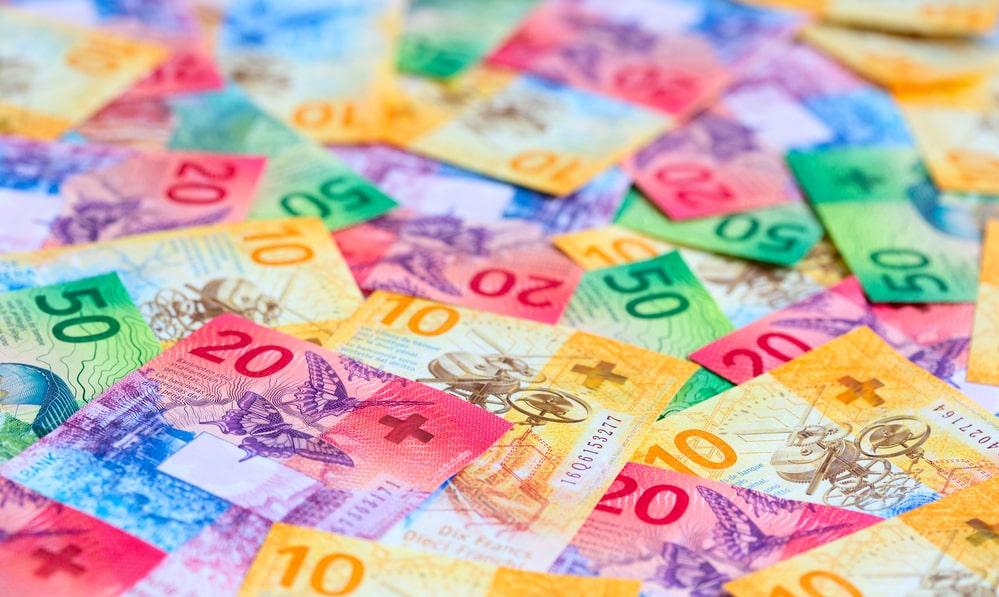

Summary
- Swiss franc (CHF) is the best performing G10 currency in 2023, rising almost 5% against the US dollar (USD).
This article is only available to Macro Hive subscribers. Sign-up to receive world-class macro analysis with a daily curated newsletter, podcast, original content from award-winning researchers, cross market strategy, equity insights, trade ideas, crypto flow frameworks, academic paper summaries, explanation and analysis of market-moving events, community investor chat room, and more.
Summary
- Swiss franc (CHF) is the best performing G10 currency in 2023, rising almost 5% against the US dollar (USD).
- It has done so without fanfare, benefitting from the US banking crisis and lingering geopolitical challenges while shrugging off domestic banking challenges.
- The Swiss National Bank (SNB) has, and will continue, to buoy the currency through tighter monetary policy and verbal support. Importantly, it will keep matching European Central Bank (ECB) moves.
Market Implications
- CHF dips will be buying opportunities, especially if geopolitical tensions ratchet higher and/or a US-led global economic slowdown emerges.
- This can lead to an all-time high print in the Deutsche Bank CHF trade-weighted index (TWI), plus record highs versus the EUR, GBP, and JPY.
Introduction
The Swiss franc is the top G10 performer so far this year, gaining just below 5% against the US dollar. Investors have flocked to the CHF amid the US banking turmoil and despite the tumult surrounding Credit Suisse in Switzerland.
Expect this performance to continue in the coming months, especially given the likelihood of a US-led global recession. During economic turmoil, the CHF’s haven status is a magnet for flows, and the next recession should be no different.
The CHF should find further support from the potential, albeit currently unlikely, for a US debt default and any escalation in geopolitical tensions, such as between the US and China.
CHF to Benefit as Recession Looks Inevitable
A recession later this year appears unavoidable. The Fed’s model indicates a ~67% probability of a recession occurring in the next 12 months. Macro Hive’s model places that probability at ~85%.
Perhaps more importantly, however, the most recent FOMC minutes explicitly stated that the central bank expects a recession this year.
Specifically, the minutes stated that ‘the Fed staff’s projection at the time of the March meeting included a mild recession starting later this year with a recovery over the subsequent two years.’
Before March and the banking-sector troubles, Fed messaging was much more upbeat, with talk of a soft landing prevalent.

During economic slowdowns, the CHF is a standout outperformer in the FX space. For example, amid the global financial crisis (GFC), from mid 2007 to the end of 2008, the CHF trade-weighted index (TWI) rose 13%.
This occurred even as, according to The Economist’s Big Mac Index, the currency was overvalued by a staggering 74% in June 2007.
From mid-2010 to mid-2011, when the European sovereign debt crisis emerged, the Swiss TWI appreciated by 31%. And, again, this occurred with the currency as overvalued in July 2010 as it was in June 2007.
The key takeaway is that during economic turmoil, the CHF rallies materially. And, while the upcoming recession will probably be less acute than the GFC or European crisis, it will still probably lead to a strong CHF rally.
The Geopolitical Backdrop Remains Challenging
Back in February, my colleague Henry Occleston wrote about three possible near-term geopolitical crises for this year. These were an isolated and vulnerable Iran, trouble around Turkey’s elections, and further Russian escalation of its war against Ukraine.
Henry argued that markets are almost certainly underpricing these potential geopolitical risks, that subsequent flashpoints are high risk, and that such events may unfold rapidly.
If you add in the potential for a further deterioration of US/China relations, there are many potential flashpoints for geopolitics to impact FX markets. As NBC News in the US reported last week, ‘[d]iplomatic channels between China and the U.S. have mostly dried up as relations between the superpowers have steadily deteriorated.’
Should any of the potential flashpoints above flare up in the coming weeks and months, expect the CHF to rally materially.
How much will it rally?
No two geopolitical flareups are alike, and markets do not always react to events by the same magnitude. However, last year the CHF TWI rallied over 9% between early February and the end of September as the Ukrainian war unfolded.
Expect more of the same if geopolitical risks intensify.
The SNB Will Continue Supporting CHF
In the past year or so, the SNB has raised rates by 225bp to 1.5%. At its latest meeting on 23 March, it raised rates by 50bp, matching the move from the ECB the week before.
This is a key dynamic. The currency, specifically the EUR/CHF rate, is one of the most important inputs into SNB monetary policy.
Swiss policymakers are keen to keep pace with the ECB, so that interest rate differentials do not work against the CHF strengthening (or at least keeping pace with the EUR).
Market pricing points to this being the case. Between now and the end of the third quarter, traders expect both central banks to raise rates by at least a cumulative 50bp, with 75bp a good probability.
Since global inflation jumped last year, the SNB has been keen to support the CHF, as a stronger currency will mitigate imported inflation.
In its most recent monetary policy assessment, the central bank said that ‘to provide appropriate monetary conditions, the SNB also remains willing to be active in the foreign exchange market as necessary. For some quarters now, the focus has been on selling foreign currency.’
This will almost certainly remain the case in the coming weeks and months. As a result, with the central bank on your side, a massive historical impediment to CHF strength has been removed.
For a big chunk of the past two decades, when disinflation/deflation were the biggest fear for central bankers, the SNB sold CHF into the market. Many traders were caught on the wrong side of SNB intervention.
Now, with the opposite being true, traders can seek the safety of the haven CHF knowing that the central bank will oppose them. This is a huge advantage.
A Look at Four CHF Pairs
We now consider four of the key CHF pairs: EUR/CHF, USD/CHF, GBP/CHF and CHF/JPY.
EUR/CHF
From a trade and monetary policy perspective, EUR/CHF is the most important and closely watched CHF currency pair.
EUR/CHF printed an all-time low (on a closing basis) in late September, and while it has retraced some of the 2022’s big down move, the franc is still materially stronger than it was against the euro a year ago.

Currently, EUR/CHF trades about 3% above the all-time low cited above.
Should a US-led recession develop, expect EUR/CHF to grind back towards the September low, where it will probably meet some support.
If geopolitical tensions heighten, the pair should make a new record low, especially if a recession also occurs.
Either way, CHF strength is a reasonable expectation.
USD/CHF
Both the franc and the dollar are safe havens. However, expect the CHF to keep outperforming, as it has since January.
USD/CHF price action this year has been instructive, and probably provides a decent playbook for the rest of this year.

When Silicon Valley Bank failed and wider concerns for the US banking sector emerged, the franc appreciated just over 3% versus the dollar.
When the contagion spread to Credit Suisse, USD/CHF retraced about two thirds of that move, before resuming the initial reaction of a stronger franc two days later.
Net/net, since the most recent peak in USD/CHF in early March, the franc has strengthened ~6.25% versus the dollar.
Looking ahead, the spike low at ~0.8400 in January 2015, when the SNB abandoned the EUR/CHF 1.20 floor, now seems a logical and attainable target for USD/CHF this year. If the US defaults on its debt, expect the pair to accelerate near that level quickly.
GBP/CHF
Given my bearish predisposition to sterling, the sideways price action this year in GBP/CHF has been surprising.

I do not foresee GBP resilience to last through the rest of 2023, though, and expect GBP/CHF to trade back to its all-time low at ~1.06 from last September in the coming months.
In the case of a recession, I expect GBP/CHF to mimic the price action (albeit to a lesser degree) seen during the GFC, Euro crisis and at the outset of the pandemic in 2020. In these cases, GBP/CHF fell ~40%, 35%, and 12%, respectively.
If a recession comes alongside elevated geopolitical tensions, I expect a new all-time low in GBP/CHF, with the pair trading at (and probably below) parity for the first time.
When the Ukrainian War began last year, in the six months between February and August, GBP/CHF fell ~8%. This could happen again.
CHF/JPY
Like USD/CHF, both currencies in the CHF/JPY cross are seen as havens.

As the chart clearly shows, CHF/JPY has been on an upward climb for the past 20 years. True, this ascent has been subject to material and long-lasting corrections, but the general direction of travel is clear.
Recent price action is perhaps most instructive for the coming months. Since the Ukrainian War began, CHF/JPY has risen over 20%. And CHF/JPY is up about 7.5% YTD.
This dynamic of rising CHF/JPY amid economic and geopolitical uncertainty is poised to continue through 2023. CHF/JPY printed an all-time high recently. Expect a repeat later this year, with upside momentum to continue.
Conclusion
The Swiss franc is the best-performing G10 currency so far this year, trading at or near its all-time high on a trade-weighted basis and against several developed market peers. This momentum will continue in the coming months.
With a recession looking increasingly likely, and the persistence of geopolitical risks, the haven appeal of the CHF will drive further strength this year.
Additionally, the SNB will keep supporting the CHF as it has since its recent tightening cycle began last year. Monetary policy will continue to tighten, keeping pace with the ECB, and the central bank will continue with its verbal and physical intervention in the FX markets to support the CHF.
